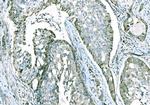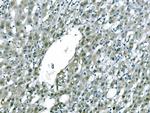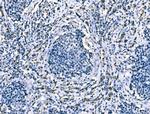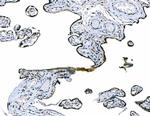Search Thermo Fisher Scientific
FIGURE: 1 / 4
CD101 Antibody (PA5-143965) in IHC (P)




Product Details
PA5-143965
Species Reactivity
Host/Isotype
Class
Type
Immunogen
Conjugate
Form
Concentration
Purification
Storage buffer
Contains
Storage conditions
Shipping conditions
RRID
Product Specific Information
Adding 0.2 mL of distilled water will yield a concentration of 500 µg/mL.
Target Information
CD101 also known as V7 antigen, a member of the Ig superfamily. CD101 is a disulfide linked homodimer of unknown function. Expression of CD101 is found on monocytes, granulocytes and dendritic cells (Langerhan-like cells HLA-DR, CD1a, CD1c). In addition expression on T lymphocytes is important for cell activation. CD101+ CD28+ cells are very responsive to CD28 signaling. In combination with anti-CD28 or suboptimal levels of anti-CD3, anti-CD101 can increase proliferation thereby suggesting an activating role. The monoclonal antibody BB27 has been shown to inhibit the T cell reactivity in allogeneic and antigen-specific mixed DC-T cell cultures. Recently it has been demonstrated that mouse CD101 is found on a subpopulation of regulatory T cells (CD4, CD25, Foxp3 positive) that have high suppressor activity. Expression of CD101 on human PBMCs shows staining of about 30% of the Foxp3 positive cells. Studies have not confirmed higher suppressor activity in the human CD101 population.
For Research Use Only. Not for use in diagnostic procedures. Not for resale without express authorization.
References (0)
Bioinformatics
Protein Aliases: CD101; Cell surface glycoprotein V7; EWI-101; Glu-Trp-Ile EWI motif-containing protein 101; IgSF2; Immunoglobulin superfamily member 2; leukocyte surface protein; RP11-27K13.2
Gene Aliases: CD101; EWI-101; EWI101; IGSF2; V7
UniProt ID: (Human) Q93033
Entrez Gene ID: (Human) 9398

Performance Guarantee
If an Invitrogen™ antibody doesn't perform as described on our website or datasheet,we'll replace the product at no cost to you, or provide you with a credit for a future purchase.*
Learn more
We're here to help
Get expert recommendations for common problems or connect directly with an on staff expert for technical assistance related to applications, equipment and general product use.
Contact tech support
